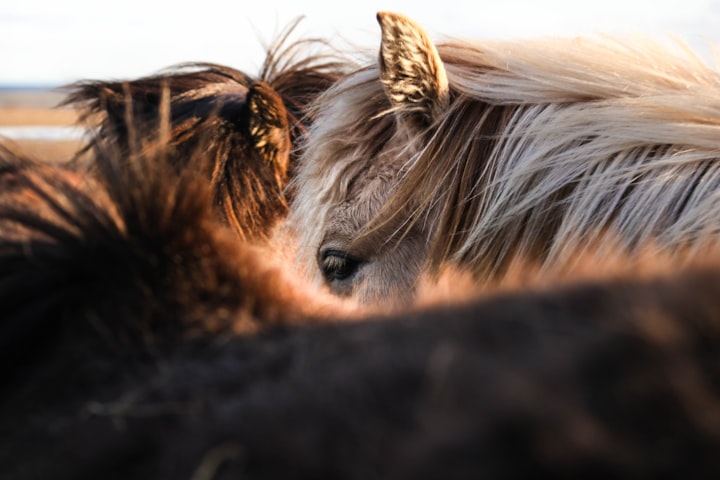Silver Ponies Are Genuine
Figuring out White Hair Hereditary qualities for Fledglings

Instructions to Detect a Silver Pony
Deplorably, a "silver" horse seems to be its metal namesake — albeit that would have been splendid! All things being equal, silver alludes to a hereditary quality that gives dull bodied ponies light manes and tails. This differentiation gives silver ponies a staggering appearance that positively knocks some people's socks off any place they go.
The mane and tail of a silver pony can differ in variety. The most widely recognized conceals are typically straw colored or shiny dark. A few ponies show an obscuring of these tones as they become older.
Not All Light Manes Demonstrate Silver
A few dark ponies have light or white manes and tails. Dissimilar to genuine silver ponies, which are dull bodied, the layer of a dark pony frequently likewise encounters moderate easing up until they are totally white when they are six or eight years of age. Dark ponies and different ponies with white hair — like tobiano, outline, and overo ponies — don't have similar variety hereditary qualities as silver ponies.

Meet PMEL17: The Silver Quality
A change in the PMEL17 quality causes the light-haired thoroughly search in silver ponies. Strangely, it weakens dim color. All the more explicitly, it eases up dark and earthy colored shade in ponies.
The impact isn't restricted to the creature's mane and tail, be that as it may. A strong dark pony will have a chocolate-shaded body and a light tail and mane. These attractive ponies are alluded to as "dark silvers". Dark ponies with the change can likewise show dim looking dappled coats, and they are designated "silver dapples."
A sound pony will show a yellowish mane and tail and diminished dark color on the lower legs, which can likewise be depicted as chocolate. These creatures are designated "inlet silvers" or "red silvers."
How Is Silver Acquired?
Silver weakening, as the condition is some of the time alluded to, is acquired as a prevailing characteristic. This implies that a foal will be "silver" if by some stroke of good luck one parent passes on the silver quality. Despite the fact that this hereditary cosmetics is apparently simple to acquire, silver is as yet viewed as one of the more extraordinary varieties in the general pony populace.
Ponies with two duplicates of the silver quality (Z/Z) are anticipated to give silver to their foals in general, whether or not they breed with a silver or non-silver pony. Those with one duplicate of the silver quality (Z/N) have a 50 percent chance of delivering a silver foal, in any event, when they are reared with a non-silver pony.
Which Breeds Are Impacted?
Many pony and horse breeds are known to convey the silver change. These include:
- Morgan ponies
- Icelandic ponies
- Shetland horses
- Wanderer Cobs
- Welsh horses
- Paint ponies
- Australian stock ponies
- Quarter Ponies (and related breeds)
- Rough Mountain ponies (and related breeds)
- French Comtois draft horse
The Principal Silver Morgan Pony
It is challenging to find the starting points of the silver quality, making it hard to make sense of why a few varieties are more "silver" than others. One could expect that every one of the impacted varieties had a productive progenitor that had the transformation. One such recorded model includes the Morgan horse breed.
It is accepted that all silver lines in Morgan ponies can be followed back to a solitary pony called Dan. This was a 1916 enlisted chestnut steed. Some accept that he created the main silver foals when he was reared with a dull inlet horse called Nellie Skinner. Nonetheless, quite possibly Nellie, and not Dan, was the first wellspring of the silver quality.

Great Looks, Awful Eyes
A transformed PMEL17 quality could give silver ponies an advantage in the magnificence division, however it frequently includes some major disadvantages. The silver transformation has been connected to an innate eye infection called Numerous Inborn Visual Irregularities condition (MCOA).
MCOA prompts a few eye deserts, for the most part close to the front or the rear of the creature's eye. The seriousness of the condition really relies on the number of duplicates of the quality the pony that has acquired from its folks. Ponies with one duplicate have less extreme side effects and could foster eye sores — that is as yet a worry, yet ponies with two duplicates frequently foster a contorted iris or retina (or both). They could likewise endure growth of the cornea.
To keep away from MCOA-related eye impedance in people in the future, reproducers are urged to test all posterity from silver ponies for this illness, in any event, when they appear to have "safe" coat colors like chestnut. Ponies with red shading, similar to chestnuts, can in any case acquire one or the two duplicates of the silver transformation.
The way that such posterity convey the silver transformation isn't clear in light of the fact that the quality doesn't influence or weaken red or yellow shade in ponies. Subsequently, a chestnut probably won't look "silver", however they can in any case foster MCOA.
A Speedy Rundown
Silver ponies rank among the most lovely ponies in the equine world, for example, the exceptionally famous silver dapple. The weakening is brought about by a transformed form of the quality PMEL17 and can be tracked down in breeds as different as horses to draft ponies. While the change just influences dark and earthy colored ponies, it can in any case cause silver-connected eye issues in ponies of different tones who likewise convey the weakening.
Thank you for watching.
About the Creator
Frame Morris
I experience watching and listening to everything around me to summarize my experiences. Always learn and explore everything according to your own feelings. Learn to do things to fix yourself.





Comments (1)
Lovely. Thank you for this story.